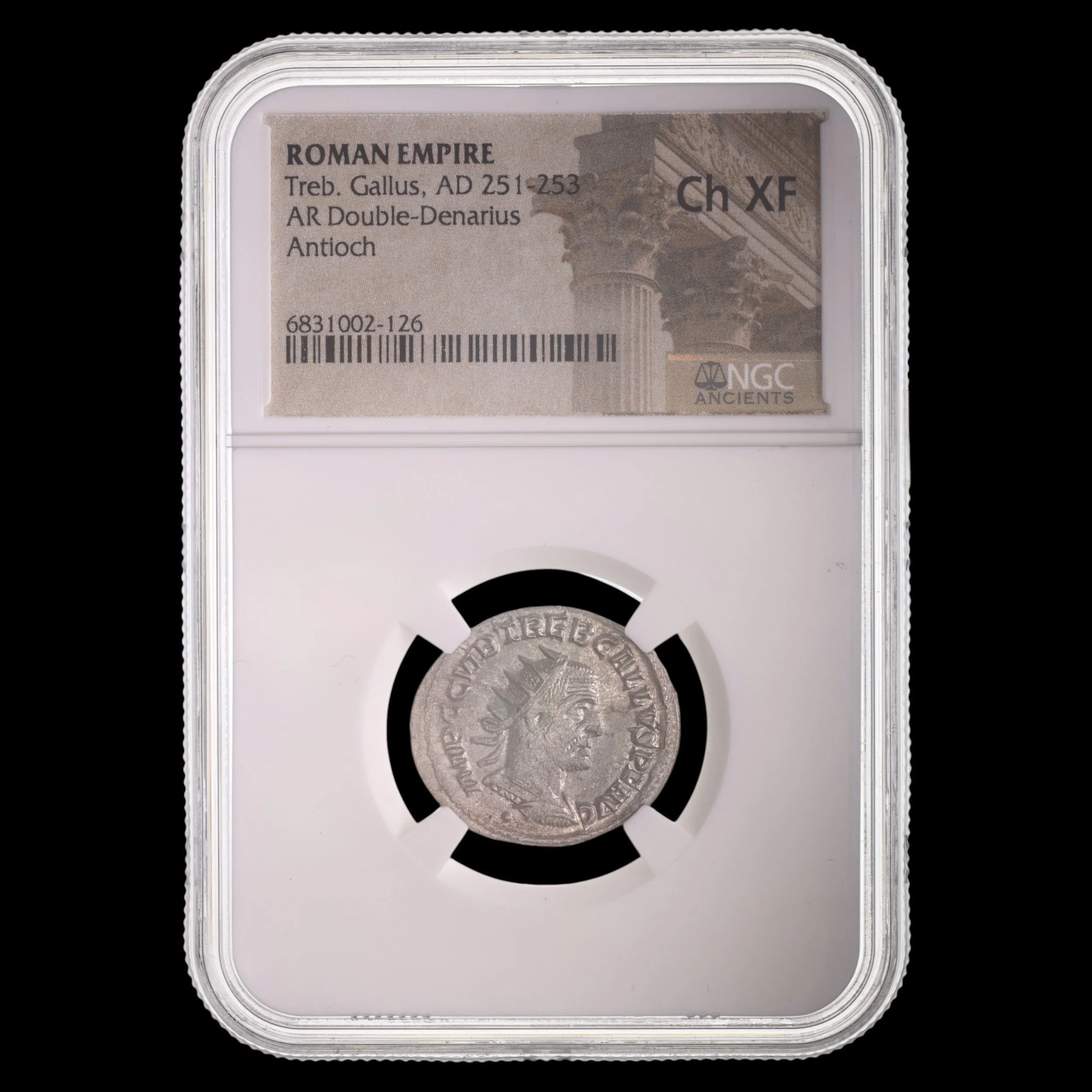 Image 1 of 7
Image 1 of 7

 Image 2 of 7
Image 2 of 7

 Image 3 of 7
Image 3 of 7

 Image 4 of 7
Image 4 of 7

 Image 5 of 7
Image 5 of 7

 Image 6 of 7
Image 6 of 7

 Image 7 of 7
Image 7 of 7








Roman Silver Coin of Emperor Trebonianus Gallus (about 1,770-1,775 years ago)
The coins shown are representative examples of the grade and type, but not the actual specimens for sale. For details on NGC’s grading standards and definitions, please refer to our NGC Grading page.
Roman AR Antoninianus Of Trebonianus Gallus (AD 251-253)
Roman Silver Coin of Emperor Trebonianus Gallus (about 1,770-1,775 years ago)
This silver-washed antoninianus portrays Emperor Trebonianus Gallus, who briefly ruled during the tumultuous Crisis of the Third Century when the Roman Empire nearly collapsed under the combined pressures of civil wars, foreign invasions, and economic instability. Taking power after Emperor Decius' death in battle against the Goths, Gallus attempted to stabilize the empire before meeting the same fate as most emperors of this chaotic period.
Coin Description:
Front side: Portrait of Emperor Trebonianus Gallus facing right, wearing a radiate crown (crown with sun-ray spikes), with Latin inscription giving his name and titles
Back side: Likely depicts personifications such as Pax (Peace), Libertas (Liberty), or other deities symbolizing the emperor's attempt to restore stability, with accompanying Latin text
Technical Details:
Silver-washed bronze composition (antoniniani of this period contained minimal silver)
Denomination: Antoninianus
NGC certified
Minted between 251-253 AD
Condition as certified by NGC
Historical Significance: Trebonianus Gallus' brief reign exemplifies the instability of the "Crisis of the Third Century," when Rome experienced what historians call the "Imperial Anarchy." After Emperor Decius and his son died fighting Gothic invaders at the Battle of Abritus in 251 AD, Gallus—commander of the remaining Roman forces—was proclaimed emperor. His most notable act was negotiating peace with the Goths, allowing them to keep their plunder and prisoners in exchange for withdrawing from Roman territory, a controversial decision seen by some as necessary pragmatism and by others as weakness. This peace was short-lived as plague ravaged the empire and new external threats emerged. When the general Aemilian revolted in 253 AD, Gallus was murdered by his own troops before the armies could engage—a fate typical of emperors during this fifty-year crisis period that saw the rapid rise and fall of over twenty emperors.
The coins shown are representative examples of the grade and type, but not the actual specimens for sale. For details on NGC’s grading standards and definitions, please refer to our NGC Grading page.
Roman AR Antoninianus Of Trebonianus Gallus (AD 251-253)
Roman Silver Coin of Emperor Trebonianus Gallus (about 1,770-1,775 years ago)
This silver-washed antoninianus portrays Emperor Trebonianus Gallus, who briefly ruled during the tumultuous Crisis of the Third Century when the Roman Empire nearly collapsed under the combined pressures of civil wars, foreign invasions, and economic instability. Taking power after Emperor Decius' death in battle against the Goths, Gallus attempted to stabilize the empire before meeting the same fate as most emperors of this chaotic period.
Coin Description:
Front side: Portrait of Emperor Trebonianus Gallus facing right, wearing a radiate crown (crown with sun-ray spikes), with Latin inscription giving his name and titles
Back side: Likely depicts personifications such as Pax (Peace), Libertas (Liberty), or other deities symbolizing the emperor's attempt to restore stability, with accompanying Latin text
Technical Details:
Silver-washed bronze composition (antoniniani of this period contained minimal silver)
Denomination: Antoninianus
NGC certified
Minted between 251-253 AD
Condition as certified by NGC
Historical Significance: Trebonianus Gallus' brief reign exemplifies the instability of the "Crisis of the Third Century," when Rome experienced what historians call the "Imperial Anarchy." After Emperor Decius and his son died fighting Gothic invaders at the Battle of Abritus in 251 AD, Gallus—commander of the remaining Roman forces—was proclaimed emperor. His most notable act was negotiating peace with the Goths, allowing them to keep their plunder and prisoners in exchange for withdrawing from Roman territory, a controversial decision seen by some as necessary pragmatism and by others as weakness. This peace was short-lived as plague ravaged the empire and new external threats emerged. When the general Aemilian revolted in 253 AD, Gallus was murdered by his own troops before the armies could engage—a fate typical of emperors during this fifty-year crisis period that saw the rapid rise and fall of over twenty emperors.



































